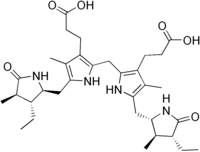Stercobilinogen
This article needs additional citations for verification. (May 2009) |

| |
| Names | |
|---|---|
| IUPAC name
3-[2-[[3-(2-carboxyethyl)-5-[[(2S,3R,4R)-4-ethyl-3-methyl-5-oxopyrrolidin-2-yl]methyl]-4-methyl-1H-pyrrol-2-yl]methyl]-5-[[(2S,3R,4R)-3-ethyl-4-methyl-5-oxopyrrolidin-2-yl]methyl]-4-methyl-1H-pyrrol-3-yl]propanoic acid
| |
| Other names
Fecal urobilinogen
| |
| Identifiers | |
| |
3D model (JSmol)
|
|
| ChEBI | |
| ChemSpider | |
| MeSH | Stercobilinogen |
PubChem CID
|
|
| UNII | |
CompTox Dashboard (EPA)
|
|
| |
| |
| Properties | |
| C33H48N4O6 | |
| Molar mass | 596.769 g·mol−1 |
Except where otherwise noted, data are given for materials in their standard state (at 25 °C [77 °F], 100 kPa). | |
| Infobox references | |
Stercobilinogen (fecal urobilinogen) is a chemical created by bacteria in the gut. It is made of broken-down hemoglobin. It is further processed to become the chemical that gives feces its brown color.[1]
Bilirubin is a pigment that results from the breakdown of the heme portion of hemoglobin. The liver conjugates bilirubin, making it water-soluble; and the conjugated form is then excreted in urine as urobilinogen. Urobilinogen is colourless and is further oxidised to stercobilin which imparts colour to feces. Darkening of feces upon standing in air is due to the oxidation of residual urobilinogens to urobilins. In the intestine, bilirubin is converted by bacteria to stercobilinogen. Stercobilinogen is absorbed and excreted by either the liver or the kidney. Stercobilinogen is oxidized to stercobilin, which is responsible for the pigmentation of feces.
In early liver disease, impaired biliary excretion causes sterocobilinogen to be absorbed mostly by the kidney[clarification needed], and, therefore, stercobilinogen will appear in the urine in excess as urobilinogen. This happens because "Stercobilinogen" is simply the name given to Urobilinogen in the GI tract;[2] and in fact its use as a separate term has fallen out of favor due to the confusion.
References[]
- ^ Stercobilinogen, drugs.com
- ^ Higgins, C. (2012). Understanding Laboratory Investigations: A Guide for Nurses, Midwives and Health Professionals. Wiley. p. 181. ISBN 9781118480137. Retrieved 2015-04-13.
Harpers illustrated biochemistry 28th Ed.
Harrison’s principles of internal medicine 20th Ed.
- Pyrroles
- Gamma-lactams